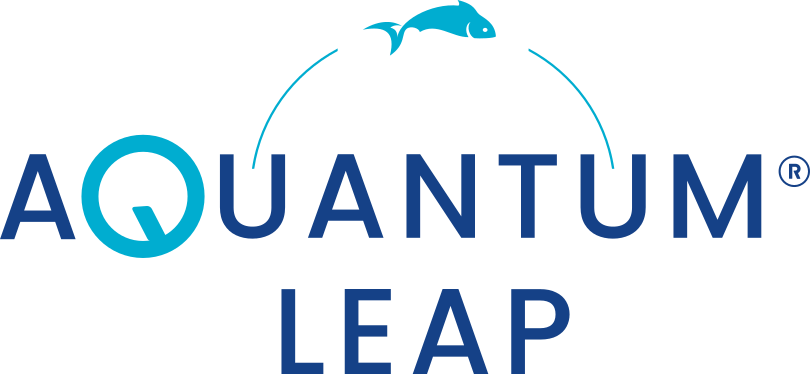Aquantum Leap is a closed fish farm consisting of Aquantum 500K, a fish cage for adult salmon, and Aquantum 12K, a post smolt facility, The former, 500K has a volume of 500,000 m³ and is probably the world’s largest closed fish cage. 12K consists of several smaller closed cages gathered in a rigid frame, specially adapted for the production of post-smolt. Both facilities have solutions for sectioning and sorting of fish and are adapted to most localities where there is salmon farming today.
In addition to answering the sustainability challenges for cage culture today, Aquantum Leap is also the first fish farming system that embrace large scale production with fully integrated and automated operations. We believe economies of scale is important for the cage culture industry in order to achieve the desired growth.
The fish farming system facilitates sustainable production.

The world's largest closed fish cage
Aquantum 500K is probably the world’s largest planned closed fish cage. It has a diameter of 120 m and a depth of 60 m. Aquantum 500K holds 500,000 m³, and one 500K corresponds to 1% of the total salmon production in Norway today. All operations are automated and integrated into the steel structure. The volume can be sectioned into three adjustable parts. These sections can be sealed apart, or separated by nets that allow water to flow through. These possibilities for sectioning effectively provide opportunities to sort, starve, process and deliver fish. Sludge is collected by sedimentation and transported continuously out of each farming cage and processed at the plant. The entire steel structure can be lifted out of water for washing, maintenance and disinfection without the use of service vessels. Aquantum 500K is patented.

Closed fish farm for post smolt
When a rigid fish cage is closed, the water inside the fish cage is forced to move with the cage. This free liquid surface effect can lead to sloshing, the build up of waves inside the cage. Closed containment fish farms in the sea are significantly different from traditional net pens from a hydrodynamic and construction perspective. This implies significant differences in environmental loads from waves and currents and their effect on the structure.
FHF, the fisheries and aquaculture industry’s research funding, has funded a research project to gain more knowledge about wave loads on closed fish cages. Read more about the research project of FHF and the results here. (only in Norwegian)
A closed fish cage with the same volume as a conventional net pen must be located in a sheltered location to avoid sloshing. To achieve the goal of a sustainable severalfold increase in production, and avoid area conflicts, we must develop rigid closed fish farms that also solve the challenges of sloshing.
Both Aquantum 500K and Aquantum 12K prevents sloshing and will lie stable in all regular fjord locations where there is salmon production today.
Closed fish cages and sea loads
Når en stiv oppdrettsmerd lukkes, tvinges vannet inne i merden til å bevege seg med merden. Denne frie væskeoverflate effekten kan føre til sloshing. Lukkede oppdrettsanlegg i sjø er vesentlig forskjellig fra tradisjonelle notbaserte merder fra et hydrodynamisk og konstruksjonsmessig perspektiv. Dette innebærer signifikante forskjeller i miljølaster fra bølger og strøm og deres virkning på konstruksjonen.
FHF, Fiskeri- og havbruksnæringens forskningsfinansiering, har finansiert et forskningsprosjekt for å få mer kunnskap om bølgebelastninger på lukkede merdsystemer.
En lukket merd av tilsvarende størrelse som en konvensjonell merd må ligge på en svært skjermet lokalitet for å unngå sloshing. For å nå målet om en bærekraftig femdobling av produksjonen, og unngå arealkonflikter, må vi utvikle stive lukkede oppdrettsanlegg som løser utfordringene med sloshing.
Både Aquantum 500K og Aquantum 12K løser problemet med sloshing og vil ligge stabilt på alle lokaliteter det produseres fisk på i dag.
Salmon is a healthy and environmentally friendly source of proteins. In line with the UN’s sustainability development goals we aim to facilitate a large scale growth of salmon production and take care of the oceans and their bioderversity.
The Norwegian government has an ambitious goal of producing 5 million tonnes in 2050. In order to reach this goals a few environmental challenges must be solved. Seafarming Systems develops different fish farming solutions that not just solve the challenges of sea lice, escape and pollution of the sea, but also facilitates large scale production in order to reach the desired growth. One Aquantum Leap fish farm can produce up to 33.000 tonnes per year. 40 Aquantuum Leap facilities would cover the Norwegian yearly production of c. 1,3 million tonnes.
With a volume of 500.000 m3, the amount of sludge collected will be sufficient to create a true circular economy where the resources in the fish sludge is recycled as fertilizer or bio gas. In the development project there are plans for developing the sludge drying and recycling facilities with Skretting, Scanship, IVAR, Bellona og HØST to handle the large amount of sludge from Aquantum Leap. Sludge collection and treatment also hold the potential for recovering valuable minerals as phospor. Handling large quantities of fish sludge, and utilizing it as a resource is an important part of the total solution.
Contact:
Alf Reidar Sandstad, CEO
moc.s1713592049metsy1713592049sgnim1713592049rafae1713592049s@sra1713592049
+47 41 55 73 05
Janne Pedersen
moc.s1713592049metsy1713592049sgnim1713592049rafae1713592049s@pj1713592049
+47 90 08 90 23



